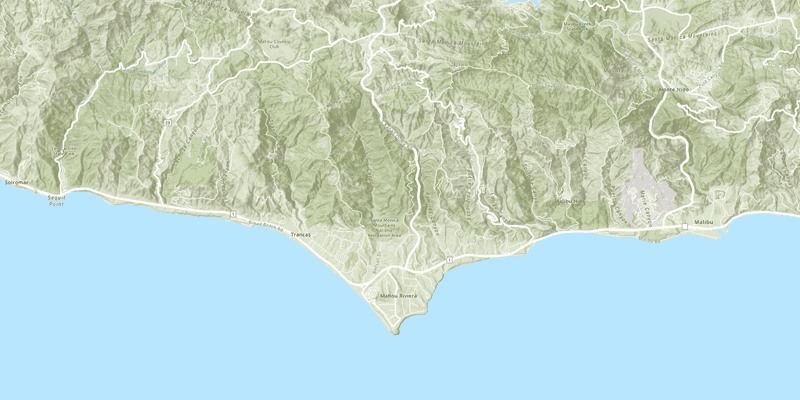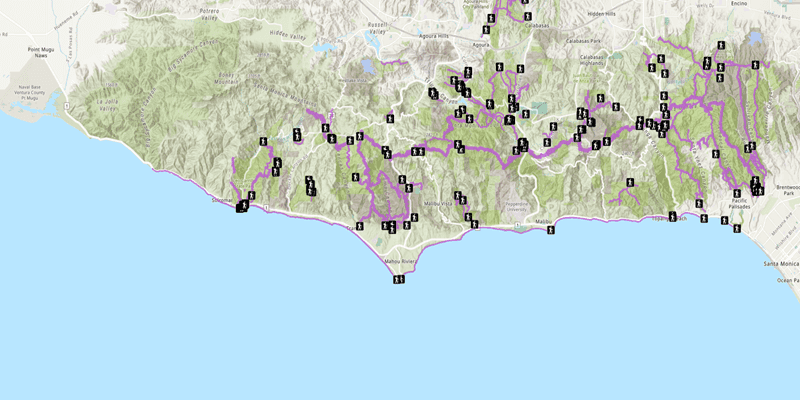Get started with the ArcGIS Runtime API for Android:
- Review system requirements
- Install and set up
- Get an access token (to access location services)
- Complete the Display a map tutorial
1. System requirements
Ensure your development environment meets the system requirements.
For an overview of this release, including enhancements, deprecations, and known issues, see the Release notes.
2. Install and set up
We recommend installing with Gradle, which will install the needed dependencies and SDK binaries from Esri's Maven repository. If you are unable to make use of Gradle, you can instead download the SDK and then add dependencies to your project manually by including the AAR library and dependency artifacts.
Get the API with Gradle
Perform the following set up steps in an existing Android Studio project, or create a new project.
-
In your settings.gradle file, within the
repositoriesblock of thedependencyblock, add aResolution Management mavenblock and specify the URL of Esri's Maven repository. Esri's repository is not open source and therefore not available fromgoogle()ormaven, so you must specify this URL.Central() settings.gradleUse dark colors for code blocks dependencyResolutionManagement { repositoriesMode.set(RepositoriesMode.FAIL_ON_PROJECT_REPOS) repositories { google() mavenCentral() maven { url 'https://esri.jfrog.io/artifactory/arcgis' } } } -
In your module-level build.gradle file, within the
dependenciesblock, add the ArcGIS Runtime SDK for Android dependency to your app.build.gradleUse dark colors for code blocks dependencies { . . . implementation 'com.esri.arcgisruntime:arcgis-android:100.15.6' } -
In your module-level build.gradle file, within the
androidblock, make sure you have the following directive to set compatibility with Java 8 language features:build.gradleUse dark colors for code blocks Copy android { . . . compileOptions { sourceCompatibility JavaVersion.VERSION_1_8 targetCompatibility JavaVersion.VERSION_1_8 } . . . } -
In your module-level build.gradle file, within the
androidblock, make sure you have abuildblock that enables view binding. For more information on view binding, see https://developer.android.com/topic/libraries/view-binding.Features build.gradleUse dark colors for code blocks Copy android { . . . buildFeatures { viewBinding true } . . . } -
In your module-level build.gradle file, within the
androidblock, make sure you have apackagingblock that excludes duplicates of theOptions METfile. This setting will prevent a compiler error that occurs if you try to include the same file in theA- IN F\ DEPENDENCIES METdirectory more than once in the output. For more information on packaging options, see https://developer.android.com/reference/tools/gradle-api/7.4/com/android/build/api/dsl/PackagingOptions.A- INF build.gradleUse dark colors for code blocks Copy android { . . . packagingOptions { exclude 'META-INF/DEPENDENCIES' } . . . }
Get the API manually
If you are unable to make use of the public Gradle repository, you can instead download the SDK and add the dependencies to your project manually by including the local AAR and all dependency artifacts. On the Downloads page, you can also download a separate PDF of the Guide documentation.
- Click the downloads link, and select the latest version of ArcGIS Runtime SDK for Android.
- Unzip the downloaded archive to a location on your development machine.
Manually add dependencies to the ArcGIS Runtime SDK for Android or use other resources contained in the download. The Android library module (.aar), found in the libs folder, contains the API jar libraries arcgis-android-api and its third-party dependencies and core native libraries.
Setting up ArcGIS Android API to work with local Maven repository
The following setup steps assume that you are working in a development environment that is disconnected from the internet. For example, behind a firewall that doesn't allow access to Maven repositories that are hosted on the internet. If you are developing with internet access, please follow Get the API with Gradle instead.
The following steps describe the setup with a Maven repository that is on your local machine; however, they can be applied in a similar way if you have a Maven server set up on your network.
Deploy SDK and its dependencies to your computer
-
Obtain the
arcgis-runtime-sdk-android-100.15.6.zip filein whatever way is compatible with the security measures at your work environment. -
Extract the contents of the archive to a location on disk.
-
From the extracted location, copy the contents of the
libs/aardirectory to the following location on your disk. (Note that your local Maven repo is the directory tree rooted at.m2\repositoryin your user directory.)mac:
/Users/[user-name]/.m2/repository/com/esri/arcgisruntime/arcgis-android/100.15.6/ Windows:
%USERPROFIL E%\.m2\repository\com\esri\arcgisruntime\arcgis-android\100.15.6\ -
Your full directory path should resemble the following:
mac (2 files):
/Users/[user-name]/.m2/repository/com/esri/arcgisruntime/arcgis-android/100.15.6/arcgis-android-100.15.6.aar /Users/[user-name]/.m2/repository/com/esri/arcgisruntime/arcgis-android/100.15.6/arcgis-android-100.15.6.pom Windows (2 files):
%USERPROFIL E%\.m2\repository\com\esri\arcgisruntime\arcgis-android\100.15.6\arcgis-android-100.15.6.aar %USERPROFIL E%\.m2\repository\com\esri\arcgisruntime\arcgis-android\100.15.6\arcgis-android-100.15.6.pom -
A list of these dependencies and the URLs from where they may be downloaded is below. You should obtain them in whatever way is compatible with the security measures at your work environment.
- gson 2.9.0: https://search.maven.org/artifact/com.google.code.gson/gson/2.9.0/jar
- androidx.browser 1.4.0: https://maven.google.com/web/index.html?q=browser#androidx.browser:browser:1.4.0
- androidx.localbroadcastmanager 1.1.0: https://maven.google.com/web/index.html?q=localbroadcastmanager#androidx.localbroadcastmanager:localbroadcastmanager:1.1.0
- httpcore5 5.0.4: https://search.maven.org/artifact/org.apache.httpcomponents.core5/httpcore5/5.0.4/jar
- httpcore5-h2 5.0.4: https://search.maven.org/artifact/org.apache.httpcomponents.core5/httpcore5-h2/5.0.4/jar
- slf4j-api 1.7.32: https://search.maven.org/artifact/org.slf4j/slf4j-api/1.7.32/jar
- commons-codec 1.15: https://search.maven.org/artifact/commons-codec/commons-codec/1.15/jar
- conscrypt-openjdk-uber 2.2.1 https://search.maven.org/artifact/org.conscrypt/conscrypt-openjdk-uber/2.2.1/jar
- spymemcached 2.12.3 https://search.maven.org/artifact/net.spy/spymemcached/2.12.3/jar
- ehcache-api 3.4.0 https://search.maven.org/artifact/org.ehcache.modules/ehcache-api/3.4.0/jar
-
Deploy the dependencies you downloaded in the previous step. You use Maven to install the dependencies in your local Maven repo.
-
Install the
mvnMaven tool.mac:
brew install mvnWindows:
See https://maven.apache.org/guides/getting-started/windows-prerequisites.html for information about installing the
mvnMaven tool. -
For androidx dependencies (
browserandlocalbroadcastmanager), run:mvn install:install-file - Dfile= <relative path to aar > - Dgroup Id= <group ID > - Dartifact Id= <artifact id > - Dversion= <version > - Dpackaging=aar - Dgenerate Pom=true -
For all other dependencies, run:
mvn install:install-file - Dfile= <relative path to aar > - Dgroup Id= <group ID > - Dartifact Id= <artifact id > - Dversion= <version > - Dpackaging=jar - Dgenerate Pom=true
-
-
Your local Maven repo should be set. We will modify the build files to use your local Maven repo in the next section.
Edit Gradle build settings and scripts
-
You should edit your project gradle.settings file to look at your local Maven repository. To do this, add
mavenas follows:Local() gradle.settingsUse dark colors for code blocks dependencyResolutionManagement { repositoriesMode.set(RepositoriesMode.FAIL_ON_PROJECT_REPOS) repositories { google() mavenCentral() mavenLocal() } } -
In your module-level build.gradle file, add the following dependencies:
build.gradleUse dark colors for code blocks dependencies { . . . implementation 'com.esri.arcgisruntime:arcgis-android:100.15.6' implementation 'com.google.code.gson:gson:2.9.0' implementation 'androidx.browser:browser:1.4.0' implementation 'androidx.localbroadcastmanager:localbroadcastmanager:1.1.0' implementation 'org.apache.httpcomponents.core5:httpcore5:5.0.4' implementation 'org.apache.httpcomponents.core5:httpcore5-h2:5.0.4' implementation 'org.slf4j:slf4j-api:1.7.32' implementation 'commons-codec:commons-codec:1.15' implementation 'org.conscrypt:conscrypt-openjdk-uber:2.2.1' implementation 'net.spy:spymemcached:2.12.3' implementation 'org.ehcache.modules:ehcache-api:3.4.0' } -
In your module-level build.gradle file, within the
androidblock, make sure you have the following directive to set compatibility with Java 8 language features:build.gradleUse dark colors for code blocks Copy android { . . . compileOptions { sourceCompatibility JavaVersion.VERSION_1_8 targetCompatibility JavaVersion.VERSION_1_8 } . . . } -
In your module-level build.gradle file, within the
androidblock, make sure you have abuildblock that enables view binding. For more information on view binding, see https://developer.android.com/topic/libraries/view-binding.Features build.gradleUse dark colors for code blocks Copy android { . . . buildFeatures { viewBinding true } . . . } -
In your module-level build.gradle file, within the
androidblock, make sure you have apackagingblock that excludes duplicates of theOptions MET. This setting will prevent a compiler error that occurs if you try to include the same file in theA- INF METdirectory more than once in the output. For more information on packaging options, see https://developer.android.com/reference/tools/gradle-api/7.4/com/android/build/api/dsl/PackagingOptions.A- INF build.gradleUse dark colors for code blocks Copy android { . . . packagingOptions { exclude 'META-INF/DEPENDENCIES' } . . . }
3. Get an access token
To access secure ArcGIS services and resources, you need to use an access token. The easiest way to get started is to obtain an access token from an API Key. Learn more about access tokens and authentication in Security and authentication.
4. Tutorials
Follow step-by-step instructions to build apps that incorporate ArcGIS Runtime functionality.
Deploy your app
When you begin developing ArcGIS Runtime apps, you are accepting Esri's end user license agreement (EULA); there is no need to authorize your development machine or devices. Once you have finished building your application, you are required to obtain a license before deploying it to production. Licensing ensures that you have the necessary permissions and legal rights to distribute and use your application in a commercial or public environment. For more information, see the License and deployment topic for details.



